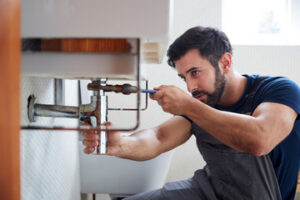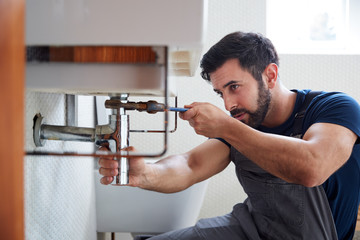Plumbers Sarasota are required to test backflow preventers yearly. Whether installing a new backflow assembly or replacing an existing one, it must be tested before it can be put into operation.
Backflow occurs when dirty water reverses flow and enters your clean water lines. This can happen due to a dip in pressure or a cross-connection. Backflow prevention devices prevent this from happening.
Backflow is a serious problem that can put people’s health at risk. It happens when sewage or chemicals from industrial sites make their way into the public water supply and then into a person’s home. The good news is that backflow prevention devices can protect homes and businesses from this danger. These devices work by installing a one-way valve on pipes that only allows water to flow in one direction. They can be installed at cross-connections, which are areas where a water supply line meets non-potable lines like garden hoses or dishwasher drain lines. The city requires that these devices be tested on a regular basis to ensure they are functioning properly.
Plumbers with backflow certification are uniquely prepared to install these devices. They know how to find the right backflow preventer for a specific situation and ensure that it is correctly installed. They also understand that these devices must be tested on a regular basis to prevent backflow and ensure they are working as designed.
The most common cause of backflow is a sudden change in water pressure. This can be caused by a spike in water demand due to a high water bill, a break in the water main, or even a fire hydrant that has been opened for fire-fighting purposes. When the water pressure drops, the water in your plumbing system will naturally flow backward to equalize the difference. This is called backsiphonage and it can contaminate the city’s clean water supply with bacteria such as Salmonella, Campylobacter jejuni, and Giardia.
This is why it’s so important to have a backflow preventer in your home or business. A professional plumber will make sure the device is the proper size and that it will seal correctly so that sewage or chemical contaminants cannot backflow into your clean water. It’s also a good idea to have a backflow preventer in place during construction of a building. This will help to avoid backflow problems in the future and keep employees or customers safe from health risks.
Backflow prevention devices must be tested on a regular basis by certified testers to ensure they are working as intended. These tests should be performed annually. The test results must be submitted to DEP on a backflow test report form and signed by a Licensed Master Plumber or the Professional Engineer or Registered Architect who submitted the initial backflow prevention plan.
Testing
In addition to finding and repairing leaks, plumbers often perform hydrostatic plumbing tests. This is a process that search for any leaks in your plumbing drain lines that are located under the slab of your home or in the pier and beam foundation. It is a great way to keep your property safe and protect it against future damage from slab leaks and leaky pier and beam plumbing drains that aren’t discovered until it’s too late.
Leaks under the slab can cause serious foundation issues. It can also be a health hazard if it’s wastewater, so finding these hidden leaks is very important. A plumber can use a simple and affordable test to find the source of these dangerous leaks. The most common method is to conduct a hydrostatic pressure test or sometimes called a water pressure test. This method is less invasive and more accurate than digging up your entire plumbing system to locate the leaks.
To begin the test, a plumber gains access to your home’s sewer cleanout access port. They then remove one of your toilets and install an inflatable ball that is inserted into the waste pipe and inflated to block it. Then, they fill the main sewer line with water until it’s up to the edge of your foundation. Then, they monitor the level for 15 minutes. If the level begins to drop, this means that there is a leak in your home’s drainage line.
If this happens, the plumber can begin to isolate smaller sections of your plumbing drain line system to determine the exact location of the leaks. They can also feed a video camera down into the pipes to see the condition of your sub-slab piping and whether it’s worth repairing or replacing them.
Another useful time to utilize a hydrostatic test is when you’re purchasing a new home. A pre-purchase plumbing test will help you avoid any unexpected problems with your new house’s plumbing drain lines. These tests are also a great option to have done after having your home’s foundation repaired to ensure that the changes haven’t caused any damage to your pipes.
Repair
Plumbers repair and maintain pipes, fixtures and equipment that provide water and gas to residential and commercial buildings. They also work on sewage and drainage systems in homes and businesses. Many plumbers have a specific area of expertise. For example, some plumbers focus on installing kitchen and bathroom sinks and toilets, bathtubs, showers, faucets and other fixtures. Other plumbers might specialize in plumbing for commercial and industrial environments, which require specialized systems to handle high volumes of waste and a larger range of heating and cooling needs.
Regardless of their specialization, all plumbers must be able to read blueprints and building specifications to design and install plumbing systems. They also need to understand a wide variety of materials and piping options, including copper, PVC, PEX, CPVC and galvanized steel. Plumbers must be able to identify and troubleshoot issues with plumbing systems, such as leaks, clogs and other problems. They often use specialty tools and diagnostic devices to find and fix problems.
Plumbing contractors and construction companies employ plumbers to install piping and fixtures in new buildings or major renovation projects. Plumbers in these positions might oversee other construction workers and may be responsible for ensuring that all work meets local building codes and regulations.
Plumbers also may be called to inspect and repair existing piping and fixtures in homes and businesses. These tasks might include testing a backflow prevention device, analyzing water flow, determining the cause of a problem and developing a plan to correct it. In some cases, this might involve replacing old or worn parts.
Plumbers that specialize in repairing and maintaining sewage and drainage systems can be exposed to dangerous microbes and pathogens while working on septic tanks and sewer lines. They might be exposed to fecal matter and vomit, which can contain infectious diseases like cholera, typhoid, hepatitis and cryptosporidiosis. As a result, these plumbers must follow strict hygiene and safety practices to prevent the spread of disease. They might wear protective clothing and gloves, and they might use specialized cleaning agents to disinfect equipment. They might also use specialized vacuum cleaners to remove solid waste from septic tanks and lines.
Maintenance
Plumbers often spend time repairing or replacing various plumbing fixtures and appliances, such as toilets, faucets, sinks, showers, garbage disposals, water heaters and other items. They also inspect and maintain existing systems, fixing leaks and clogs to keep the flow of water and waste unobstructed. Plumbers must have strong problem-solving skills to identify issues quickly and find effective solutions.
Plumbers may specialize in residential, commercial or industrial settings. Some focus on backflow prevention and other high-risk services, while others concentrate on more routine tasks. They may install and repair gas lines and plumbing equipment in new construction projects or work on older pipes and fixtures to restore functionality. Their duties can involve a wide range of tasks, including reading blueprints to determine pipe and fixture placement, testing water pressure levels and ensuring compliance with local codes and regulations.
Plumbing systems are complex, and problems can arise at any time. Whether it’s a leaky faucet or a burst pipe, these problems can cause costly damage to homes and businesses, so plumbers must be available when needed. This requires strong communication skills to relay information clearly to clients, as well as the ability to work quickly and efficiently when time is of the essence.
Plumbers need a variety of tools to carry out their duties, from basic hand tools to more advanced equipment like power drills and saws. They also need to be physically fit to handle manual labor and the repetitive motions of working with pipes and other plumbing components. They need to be able to climb stairs and ladders, work in cramped spaces and lift heavy objects. Plumbing requires patience and attention to detail, as well as the ability to follow instructions and keep accurate records. Plumbers also need to have excellent customer service skills to interact with clients in a friendly, professional manner. If you’re interested in a career as a plumber, consider starting with an apprenticeship program that offers classroom instruction and paid on-the-job training. These programs typically last two to five years and prepare you for a career in the field.
